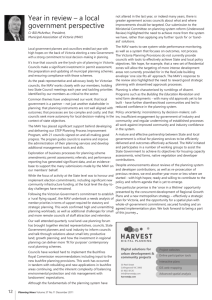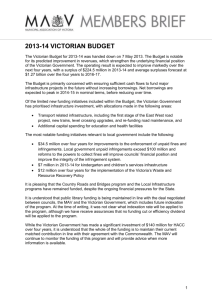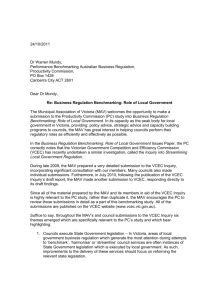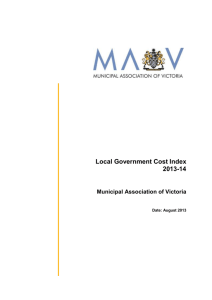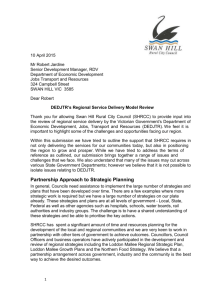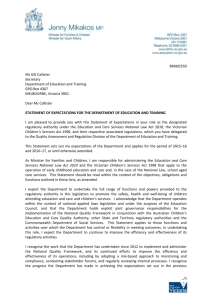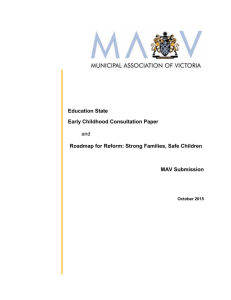submission to the IRC (Word – 308KB)
advertisement
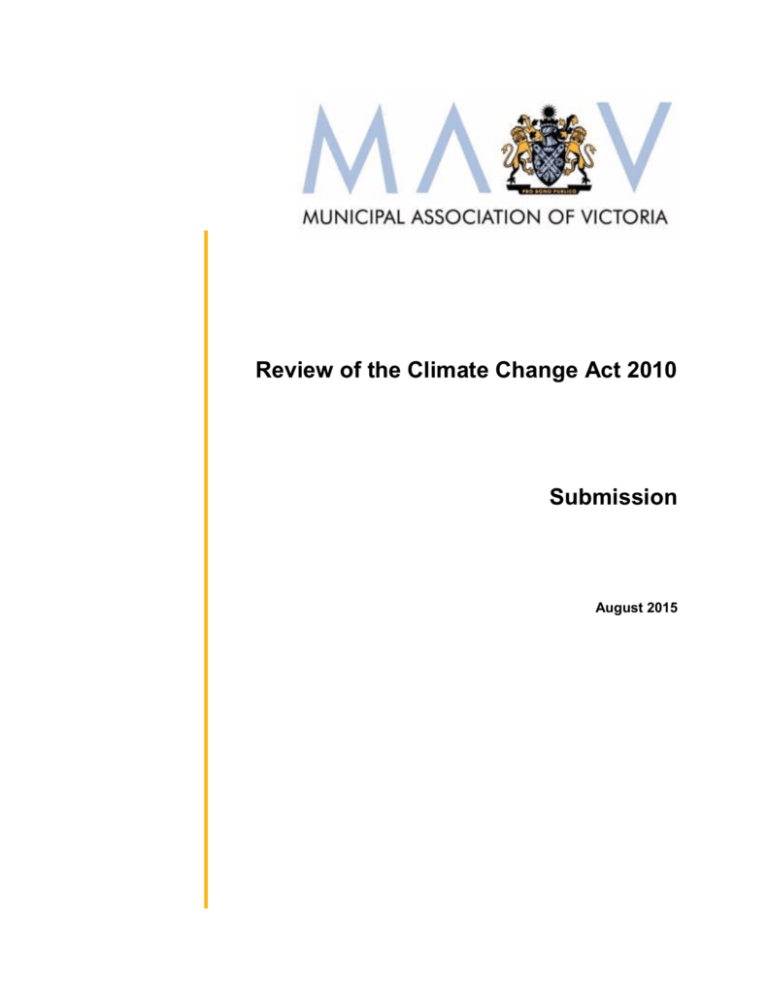
Review of the Climate Change Act 2010 Submission August 2015 © Copyright Municipal Association of Victoria, 2015. The Municipal Association of Victoria (MAV) is the owner of the copyright in this publication. No part of this publication may be reproduced, stored or transmitted in any form or by any means without the prior permission in writing from the Municipal Association of Victoria. All requests to reproduce, store or transmit material contained in the publication should be addressed to Claire Dunn on (03) 9667 5555. The MAV does not guarantee the accuracy of this document's contents if retrieved from sources other than its official websites or directly from a MAV employee. MAV submission to Climate Change Act review - Aug 2015 Table of contents 1 Introduction ......................................................................................................................... 4 2 How effective is the current Climate Change Act 2010 in driving climate change action by government, business and the community? ............................................................................... 4 3 What role should the Act play in: ......................................................................................... 5 3.1 Reducing greenhouse gas emissions? ............................................................................. 5 3.2 Adapting and preparing for the impacts of climate change? ......................................... 6 3.3 Growing a globally competitive Victorian economy?..................................................... 6 3.4 Providing accessible information to the Victorian community on climate change? ........ 7 MAV submission to Climate Change Act review - Aug 2015 1 Introduction The Municipal Association of Victoria (MAV) welcomes the opportunity to provide input into the review of the Climate Change Act 2010. As the statutory peak body for local government in Victoria, the MAV works to represent and advance the interests of all Victorian councils. The MAV supports the Government’s commitment to positioning Victoria as a leader in responding to climate change. It is incumbent on the Federal and State Governments to lead efforts to reduce greenhouse gas emissions and to be at the forefront of adaptation planning and investment. Councils are committed to working collaboratively with other levels of government, industry and the community to deliver outcomes that help support sustainable living and preserve the environment for future generations. The effects of climate change and an increase in extreme weather events are critical considerations in local government land use planning, asset management and service delivery decisions. For several years now Victorian councils have led the way in undertaking a range of actions and projects to help mitigate and protect their communities against the impacts of climate change. The Victoria Adaptation and Sustainability Partnership (VASP) and its predecessor, the Victorian Local Government Sustainability Accord, have greatly assisted local government adaptation action through knowledge sharing and grant assistance. 2 How effective is the current Climate Change Act 2010 in driving climate change action by government, business and the community? In the MAV’s view it is doubtful that the Climate Change Act has been effective in driving climate change action by government, business and the community. While the preamble of the Act indicates a whole-of-Parliament acceptance of climate change science and the imperative to take action, the Act currently only requires a very narrow cohort of decision makers to have regard to climate change. If the State is genuinely committed to being a leader of climate change action then the list of Acts in Schedule 1 must be extended to ensure climate change considerations influence decision-making across government. The 2013 National Greenhouse Accounts inventory for Victoria indicates that stationary energy, transport and agriculture are the biggest contributors to Victoria’s overall emissions, with stationary energy contributing close to 80 percent of the state’s emissions. Schedule 1 of the Act must include legislation that guides energy, transport, agriculture, infrastructure, land use planning, emergency management, mining and biodiversity decision making. 4 In terms of the effectiveness of the Climate Change Act in driving climate change action at the local level, it is difficult to assess this without first knowing how much action it drives at the State level. If, for example, it were suggested that the VASP would not exist in the absence of the Climate Change Act then councils would almost certainly argue that the Act has been very effective in driving climate change action. Certainly, as far as the MAV is aware, the Climate Change Act is not considered a go-to tool or resource for councils in order to advance their climate change adaptation or mitigation agendas. There are numerous drivers for local government climate change action, including community advocacy, councils’ own sense of responsibility to respond to the risks and opportunities that climate change brings, and availability of funding and resources through programs such as VASP and the Community Energy Efficiency Program (CEEP). The Climate Change Act requirement for municipal public health and wellbeing plans to have regard to climate change has also assisted councils to integrate climate change considerations into their planning and policy. In addition to updating the Act to ensure it reflects current local, national and international climate change policy settings, we believe there are a number of changes that should be made to strengthen the Act. These enhancements are identified in the section below. 3 What role should the Act play in: 3.1 Reducing greenhouse gas emissions? The Act should establish a Victorian greenhouse emissions reduction target and operate as a strong enabler for the target to be met. Councils consider targets to be a fundamental driver of climate change action. While the Act requires the Minister to prepare an adaptation plan, there is no such requirement for mitigation. More detail should be provided in the Act to drive meaningful and timely action and to establish accountability measures. The State’s roles and responsibilities should be clearly articulated, as should the roles and responsibilities of other partners including local government, industry and the community. We note that both the South Australian and Australian Capital Territory (ACT) Climate Change Acts refer to greenhouse emissions reduction in their titles; set targets for the use and generation of renewable energy; and clearly specify the various climate change–related functions of the Minister. We recommend that the Victorian Act does the same. Both the South Australian and the ACT Acts also provide for the establishment of a Climate Change Council, comprising representatives of state and local government, the business sector, the environment and conservation sector, the climate change science community, and other sectors of the community more generally, to provide independent advice to the Minister. We 5 recommend that the Independent Review Committee consider the merits of replicating this model in Victoria. 3.2 Adapting and preparing for the impacts of climate change? The Act should be an enabler of climate change action across Government and by business and the community, and it should support the Government to implement its various emissions reduction, energy efficiency and renewable energy election commitments. The Act should also provide a platform for the State to lead by example by requiring each Department to regularly report on the climate change action it has taken. The Act requires the Minister to prepare a Climate Change Adaptation Plan that, in part, sets out the Government’s roles and responsibilities in managing climate change risks, as well as the roles and responsibilities of other governments, persons or bodies. In 2014, the MAV entered into a Climate Change Adaptation Memorandum of Understanding (MoU) with the then Minister in order to formalise the relationship between state and local government and to provide a framework for action. The MoU committed the parties to developing a work plan however, following the change of government, the status of the MoU remains unclear and the development of the work plan is yet to commence. One of the primary objectives of the work plan was to increase clarity around state and local governments’ shared and respective adaptation responsibilities. Role clarity and ensuring that responsibilities are aligned with parties’ strengths, capacity and capabilities is critical in order to drive climate change adaptation action. It is essential that the State works in accordance with the Victorian State Local Government Agreement when contemplating new or revised roles for local government. We note that one of the stated purposes of the Act is `to promote collaboration, cooperation and innovation in the Victorian response to climate change by strengthening the role of communities and other measures.’ The Act is then silent on how this will be achieved. Again, we recommend that further detail be provided articulating who will lead a process to identify and coordinate implementation of priority actions in order to ensure this purpose is met. Many councils support an emphasis on programs and initiatives that assist vulnerable sectors of the community with both mitigation measures and adaptation relating to climate change. We note that the VASP, and perhaps more so its predecessor, has been a significant enabler of collaborative climate change action resulting in many successful partnership projects between the State, local government and the community. 3.3 Growing a globally competitive Victorian economy? Victoria’s economic and environmental wellbeing are interdependent and both are essential to Victoria’s liveability and prosperity. The economic and social benefits of climate change action, and the costs of inaction, should be articulated in the Act. 6 Consideration should be given to the role the Act can play in supporting and promoting business initiatives and technological advances that may assist in dealing with climate change or in reducing greenhouse gas emissions. The Act should facilitate and encourage clean energy development (stationary and transport), research and development of clean technology and mitigation processes, and education and capacity-building. The efforts of Victorian industry to reduce their emissions and to adapt to climate change should be supported. Likewise energy efficiency initiatives, which have the dual benefit of reducing greenhouse gas emissions as well as reducing business and households’ energy costs, should be supported by the Act. 3.4 Providing accessible information to the Victorian community on climate change? In order to avoid information overload and duplication, the respective climate change-related reporting roles and responsibilities of the Minister, the Department, the Commissioner for Environmental Sustainability, and any other agencies should be identified in the Act so that it is clear who reports what and how often. In order to encourage understanding and action at the local level it is critical that the community has access to information that clearly illustrates the current and future impacts of climate change on their everyday lives. It is also essential that councils have access to information that is sufficiently robust to support local decision making and policy setting processes. Understanding climate change risks and scenarios is an ongoing and significant challenge for councils when administering their land use planning obligations, planning for and protecting council assets (such as drainage and roads) and facilitating future mitigation infrastructure. Complex modelling is required and there are policy settings that need to be put in place in order to ensure that such modelling is meaningful. In providing input to this submission, a number of councils noted the need for sea level rise data that enables an assessment of impacts at different sections of the coast, rather than assuming a state-wide 0.8m sea level rise. In a similar vein, a number of inland councils noted the need for rainfall intensity and flood modeling to inform their land use planning decisions. There would be clear benefits for decision-makers, and for the communities they represent, if the Act could address these critical information gaps and do so in a timely manner. At a minimum, there needs to be a clear articulation of how the Climate Change Act interfaces with the Planning and Environment Act 1987. 7
